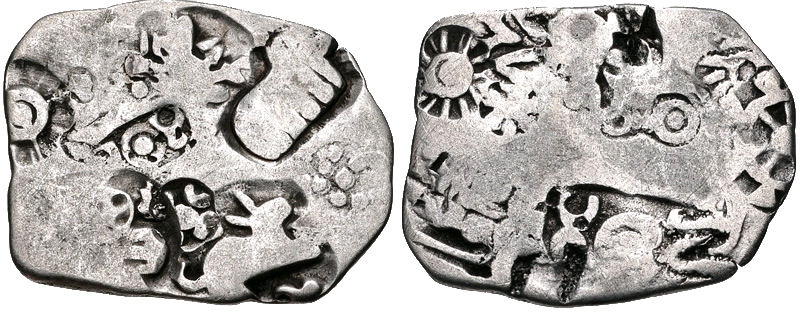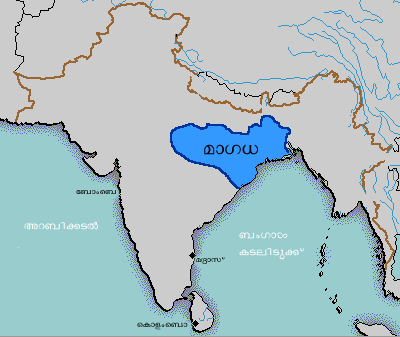|
Magadha Kingdom
Magadha was a region and one of the sixteen sa, script=Latn, Mahajanapadas, label=none, lit=Great Kingdoms of the Second Urbanization (600–200 BCE) in what is now south Bihar (before expansion) at the eastern Ganges Plain. Magadha was ruled by Brihadratha dynasty, Pradyota dynasty (682–544 BCE), Haryanka dynasty (544–413 BCE), the Shaishunaga dynasty (413–345 BCE) and the Mauryan dynasty by the end of it. Villages had their own assemblies under their local chiefs called ''Gramakas''. Their administrations were divided into executive, judicial, and military functions. Magadha played an important role in the development of Jainism and Buddhism. It was succeeded by four of northern India's greatest empires, the Nanda Empire (c. 345–322 BCE), Maurya Empire (c. 322–185 BCE), Shunga Empire (c. 185–78 BCE) and Gupta Empire (c. 319–550 CE). The Pala Empire also ruled over Magadha and maintained a royal camp in Pataliputra. The Pithipatis of Bodh Gaya referred to them ... [...More Info...] [...Related Items...] OR: [Wikipedia] [Google] [Baidu] |
Iron Age In India
In the prehistory of the Indian subcontinent, the Iron Age succeeded Bronze Age India and partly corresponds with the megalithic cultures of India. Other Iron Age archaeological cultures of India were the Painted Grey Ware culture (1300–300 BCE) and the Northern Black Polished Ware (700–200 BCE). This corresponds to the transition of the Janapadas or principalities of the Vedic period to the sixteen Mahajanapadas or region-states of the early historic period, culminating in the emergence of the Maurya Empire towards the end of the period. The earliest evidence of iron smelting predates the emergence of the Iron Age proper by several centuries. North India R. Tewari (2003) radiocarbon dated iron artefacts in Uttar Pradesh, including furnaces, tuyeres, and slag between c. 1800 and 1000 BCE. The use of iron and iron working was prevalent in the Central Ganga Plain and the Eastern Vindhyas from the early second millennium BCE. The beginning of the use of iron has been trad ... [...More Info...] [...Related Items...] OR: [Wikipedia] [Google] [Baidu] |
Nāgadāsaka
Nāgadāsaka was the last ruler of Haryanka dynasty from 437 to 413 BCE and son of Munda. He murdered his father and ruled for twenty-four years. The people deposed him and made Shishunaga king in his place. Shishunaga was the founder of Shishunaga dynasty. According to Buddhist tradition, he was the last of Haryanka rulers who was replaced by his '' amatya'' (minister), Shishunaga Shishunaga ( IAST: Śiśunāga, or Shusunaga) (c. 413 – 395 BCE) was the founder of the Shishunaga dynasty of the Magadha Empire in the present day northern India. Initially, he was an ''amatya'' (official) of the Magadha empire under the Hary .... References Citations Sources * {{DEFAULTSORT:Nagadasaka 5th-century BC Indian monarchs Kings of Magadha ... [...More Info...] [...Related Items...] OR: [Wikipedia] [Google] [Baidu] |
Nanda Empire
The Nanda dynasty ruled in the northern part of the Indian subcontinent during the fourth century BCE, and possibly during the fifth century BCE. The Nandas overthrew the Shaishunaga dynasty in the Magadha region of eastern India, and expanded their empire to include a larger part of northern India. Ancient sources differ considerably regarding the names of the Nanda kings and the duration of their rule, but based on the Buddhist tradition recorded in the '' Mahavamsa'', they appear to have ruled during ''circa'' 345–322 BCE, although some theories date the start of their rule to fifth century BCE. The Nandas built on the successes of their Haryanka and Shaishunaga predecessors, and instituted a more centralised administration. Ancient sources credit them with amassing great wealth, which was probably a result of introduction of new currency and taxation system. Ancient texts also suggest that the Nandas were unpopular among their subjects because of their low status birth, e ... [...More Info...] [...Related Items...] OR: [Wikipedia] [Google] [Baidu] |
Shaishunaga Dynasty
The Shaishunaga dynasty (IAST: Śaiśunāga, literally "of Shishunaga") is the fourth ruling dynasty of Magadha, an empire of ancient India. According to the Hindu ''Puranas'', this dynasty was the second ruling dynasty of Magadha, succeeding Nagadashaka of the Haryanka dynasty. Shishunaga, the founder of the dynasty, was initially an ''amatya'' or "minister" of the last Haryanka dynasty ruler Nāgadāsaka and ascended to the throne after a popular rebellion in c. 413 BCE. The capital of this dynasty initially was Vaishali; but later shifted to Pataliputra, near the present day Patna, during the reign of Kalashoka. According to tradition, Kalashoka was succeeded by his ten sons. This dynasty was succeeded by the Nanda Empire in c. 345 BCE. Establishment According to Buddhist tradition, Shishunaga was ''amatya'' in Haryanka kingdom, who revolted and became the king. Rulers Shishunaga Shishunaga founded his dynasty in 413 BCE with its capital in Rajgir and later Pataliputra (b ... [...More Info...] [...Related Items...] OR: [Wikipedia] [Google] [Baidu] |
Haryanka Dynasty
The Haryanka dynasty was the third ruling dynasty of Magadha, an empire of ancient India, which succeeded the Pradyota dynasty and Barhadratha dynasty. Initially, the capital was Rajagriha. Later, it was shifted to Pataliputra, near the present-day Patna in India during the reign of Udayin. Bimbisara is considered as the main founder of the dynasty. According to the Buddhist text, the Mahavamsa, Bimbisara was appointed king by his father, Bhattiya, at the age of fifteen. This dynasty was succeeded by the Shishunaga dynasty. Governance The governance structure of Haryanka dynasty is mentioned in ancient texts. They mention ''gramakas'' (village headmen) who headed village assemblies and ''mahamatras'' (high-ranking officials) who had executive, judicial and military functions. Historically, this period coincided with the Achaemenid conquest of the Indus Valley during the rule of Darius I from about 517/516 BCE. Rulers Bimbisara Bimbisara reigned from 545 to 493 BCE. Th ... [...More Info...] [...Related Items...] OR: [Wikipedia] [Google] [Baidu] |
Pradyota Dynasty
Pradyota dynasty, also called ''Prthivim Bhoksyanti'' (lit. enjoying the earth), is an ancient Indian dynasty, which ruled over Avanti and Magadha, though most of the Puranas ''(except a manuscript of the Brahmanda Purana, preserved in the University of Dhaka)'' say that this dynasty succeeded the Brihadratha dynasty in Magadha. The dynasty ruled for 138 years. ''Pradyota'' is the founder of the dynasty and ruler of Avanti & Magadha. Pradyota dynasty was Second dynasty who ruled Magadha. Pradyota was son of Pulika (''Punika''), who is said to have killed Ripunjaya of Brihadratha dynasty at Rajagriha, to make his son the king. Pradyota dynasty was preceded by Brihadratha dynasty and succeeded by Haryanka dynasty of Magadha. Pradyota is said to have ruled for 23 years. Palaka's reign started in (659–635 BCE) according to ''Visarasreni'' of Merutunga. He was the son of Chanda Pradyota of Magadha. He is said to have conquered Kosambi. Palaka is said to have ruled for 2 ... [...More Info...] [...Related Items...] OR: [Wikipedia] [Google] [Baidu] |
.png)



